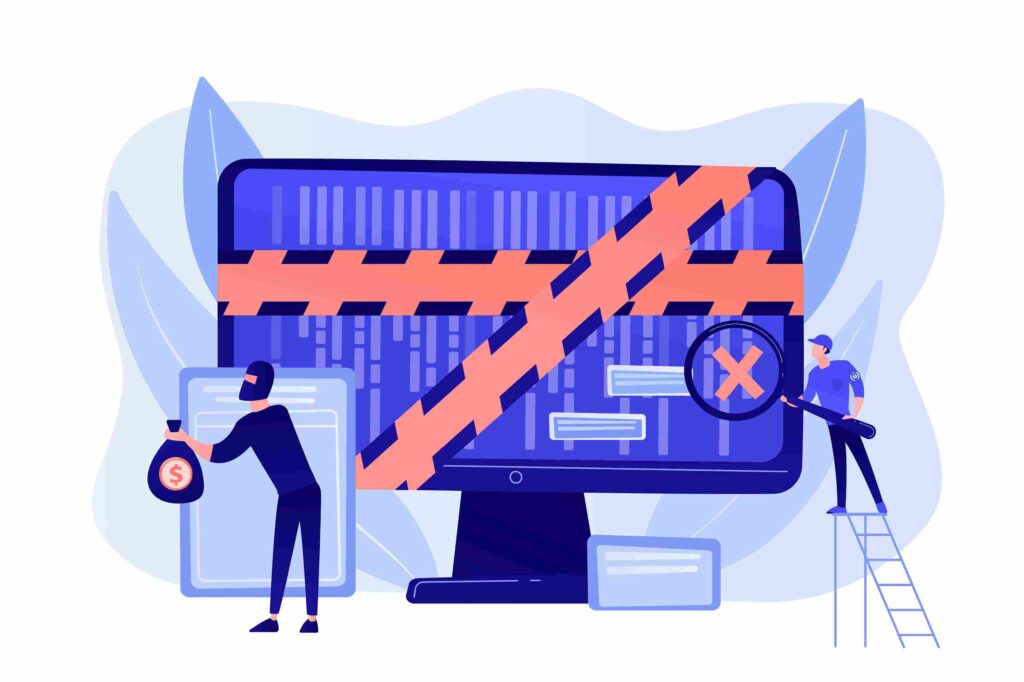Alright, let’s be honest: building a website in 2025 seems easy. There are tons of tools, templates, and “gurus” everywhere. But here’s the kicker: just because you can build a website doesn’t mean you’ll build a good one. In fact, many businesses, even big ones, are still making critical website design mistakes that hurt their brand, drive away customers, and lose sales.
Think of it like this: you wouldn’t open a physical store with a confusing layout, broken doors, or blurry signs, right? The same goes for your digital storefront. This article is your ultimate checklist, revealing the top 10 website design mistakes you absolutely must avoid in 2025. We’re giving you practical, actionable advice to help you build a website that not only looks great but actually works for your business. Ready to audit your site and stop making costly errors? Let’s dive in!

Why Avoiding Website Design Mistakes Is Non-Negotiable in 2025
The digital landscape is more competitive and user-centric than ever. Your audience has sky-high expectations, and if your website doesn’t meet them, they’ll leave without a second thought. Avoiding common website design mistakes isn’t just about aesthetics; it’s about:
- Saving Money: Fixing errors post-launch is always more expensive than building it right the first time.
- Boosting Conversions: A seamless, trustworthy website converts visitors into customers. A flawed one drives them away.
- Building Trust: A professional, error-free website signals reliability and credibility.
- Improving SEO: Many design mistakes directly impact your search engine rankings, making your site harder to find.
- Standing Out: While others are stumbling, your flawless site will shine.
Let’s get into the top offenders and how you can avoid them.
The Top 10 Website Design Mistakes You Must Avoid Now
Here are the most common pitfalls we see businesses fall into, and precisely how to steer clear of them for effective website design.
Mistake #1: Ignoring Mobile Responsiveness (The “Desktop-Only” Trap)
This is hands down the biggest and most common website design mistake. In 2025, over 60% of website traffic comes from mobile devices, and Google uses mobile-first indexing. If your website isn’t optimized for smartphones and tablets, you’re alienating the majority of your potential audience and hurting your SEO.
- How to Avoid: Design your website with a “mobile-first” approach. This means thinking about how your content and layout will appear on the smallest screens before optimizing for desktops. Use responsive design principles (which most modern themes and builders handle automatically, but always double-check!). Test your site on multiple devices and screen sizes.
Mistake #2: Slow Loading Times (The Patience Killer)
Online users are incredibly impatient. Studies show that if your website takes more than 2-3 seconds to load, a significant percentage of visitors will “bounce” (leave your site). This is a critical website design mistake that directly impacts conversions and SEO.
- How to Avoid:
- Optimize Images: Compress images before uploading them. Use modern formats like WebP.
- Choose Good Hosting: Invest in reliable and fast web hosting.
- Minimize Code: Reduce unnecessary CSS and JavaScript.
- Use Caching: Implement caching plugins or server-side caching to speed up load times.
- Limit External Scripts: Be mindful of how many third-party tools (analytics, ads, pop-ups) you’re loading.
Mistake #3: Confusing Navigation (The Digital Maze)
If visitors can’t easily find what they’re looking for, they’ll get frustrated and leave. A complicated or illogical navigation structure is a huge website design mistake.
- How to Avoid:
- Keep It Simple: Use clear, concise labels for your menu items (e.g., “Services,” “About Us,” “Contact”).
- Logical Structure: Group related pages together. Use breadcrumbs for deeper navigation.
- Prominent Placement: Your main navigation should be easy to find, usually at the top of the page.
- Search Functionality: For larger sites, a prominent search bar is essential.
Mistake #4: Unclear Value Proposition (The “What Do You Even Do?” Blunder)
When a new visitor lands on your homepage, they should instantly understand what your business does, who it’s for, and why they should care. If your message is vague or hidden, you’ve made a crucial website design mistake.
- How to Avoid:
- Strong Hero Section: Use a clear, benefit-driven headline and a concise sub-headline right at the top of your homepage.
- Visually Reinforce: Use imagery or short videos that quickly convey your core offering.
- Avoid Jargon: Speak in clear, simple language that your target audience understands.

Mistake #5: Lack of Clear Calls to Action (The “Now What?” Dilemma)
Every page on your website should have a purpose. If you don’t clearly tell visitors what to do next, they’ll do nothing. This is a common website design mistake that directly impacts your conversion rates.
- How to Avoid:
- Use Action Verbs: “Buy Now,” “Get a Free Quote,” “Download E-book,” “Learn More,” “Sign Up.”
- Make Them Visible: Use contrasting colors, ample whitespace, and strategic placement (e.g., above the fold, at the end of content sections).
- Limit Options: Don’t overwhelm users with too many competing CTAs on one page. Focus on the primary desired action.
Mistake #6: Ignoring Trust Signals (The Credibility Gap)
In a world full of scams and fleeting online trends, your website needs to instantly convey trustworthiness. Failing to do so is a significant website design mistake.
- How to Avoid:
- Display Testimonials/Reviews: Showcase what happy customers say about you.
- Show Client Logos: If you’ve worked with reputable clients, display their logos.
- Security Badges: Use SSL certificates (HTTPS is a must!), and display logos of secure payment gateways if you’re an e-commerce site.
- Clear Contact Info: Make it easy to find your address, phone number, and email.
- Professional Photography: Use high-quality images of your team, products, or services.
Mistake #7: Poor Quality or Generic Content (The “Blah” Factor)
Your content (text, images, videos) is what engages visitors and convinces them to take action. Low-quality, unoriginal, or irrelevant content is a major website design mistake.
- How to Avoid:
- Invest in Copywriting: Clear, compelling, and SEO-friendly text is crucial.
- High-Quality Visuals: Use professional photography and videography. Avoid blurry or generic stock photos unless they are exceptionally good and tailored.
- Regularly Update Content: Keep your blog, news section, and service offerings fresh and relevant.
- Solve Problems: Your content should address your audience’s pain points and offer solutions.
Mistake #8: Lack of SEO Considerations (The “Invisible” Website)
A beautiful website is useless if no one can find it. Many businesses make the website design mistake of focusing only on visuals and neglecting basic Search Engine Optimization (SEO).
- How to Avoid:
- Keyword Research: Understand what terms your audience uses to search for your products/services.
- On-Page SEO: Optimize page titles, meta descriptions, headings (H1, H2, etc.), and image alt text with keywords.
- Clean URLs: Use short, descriptive, and keyword-rich URLs.
- Sitemap & Robots.txt: Ensure search engines can crawl your site effectively.
- Mobile-Friendliness & Speed: (Again, crucial for SEO!).
Mistake #9: Overuse of Pop-ups and Intrusive Elements (The Annoyance Factor)
While pop-ups can be effective for lead capture, an overuse or poorly timed use of them can severely annoy users and lead to immediate exits. This is a common website design mistake.
- How to Avoid:
- Strategic Timing: Use pop-ups after a user has spent some time on the page or is about to leave (exit-intent pop-ups).
- Value Proposition: Offer something genuinely valuable (e.g., a discount, exclusive content) in exchange for an email.
- Easy to Close: Make sure the “X” button is prominent and functional.
- Mobile Optimization: Ensure pop-ups don’t block the entire screen on mobile devices.
Mistile #10: Neglecting Ongoing Maintenance & Updates (The “Set It and Forget It” Fallacy)
A website isn’t a “set it and forget it” asset. Ignoring updates, security patches, and content refreshes is a major website design mistake that leads to vulnerabilities, broken features, and outdated information.
- How to Avoid:
- Regular Backups: Implement a robust backup strategy.
- Software Updates: Keep your CMS (e.g., WordPress), themes, and plugins updated.
- Security Monitoring: Use security plugins and monitor for threats.
- Content Audits: Regularly review and update your content for accuracy and relevance.
- Performance Monitoring: Keep an eye on your site’s speed and fix any slowdowns.

Build a Website That Works (Not Just Looks Good!)
Avoiding these top 10 website design mistakes isn’t just about polishing your online image; it’s about building a powerful, conversion-driven asset that fuels your business growth in 2025. From ensuring mobile responsiveness and lightning-fast loading times to building trust and guiding users with clear calls to action, every detail counts. Your website is a critical investment, and preventing these common pitfalls will ensure that investment pays off.
If auditing your current site or building a new one feels overwhelming, you don’t have to do it alone. Digitalizemark specializes in crafting high-performing, user-centric websites that avoid these common website design mistakes. We focus on strategic design, robust functionality, and conversion optimization to ensure your website truly delivers results. Let us help you build an online presence that stands out, attracts clients, and drives your success.

